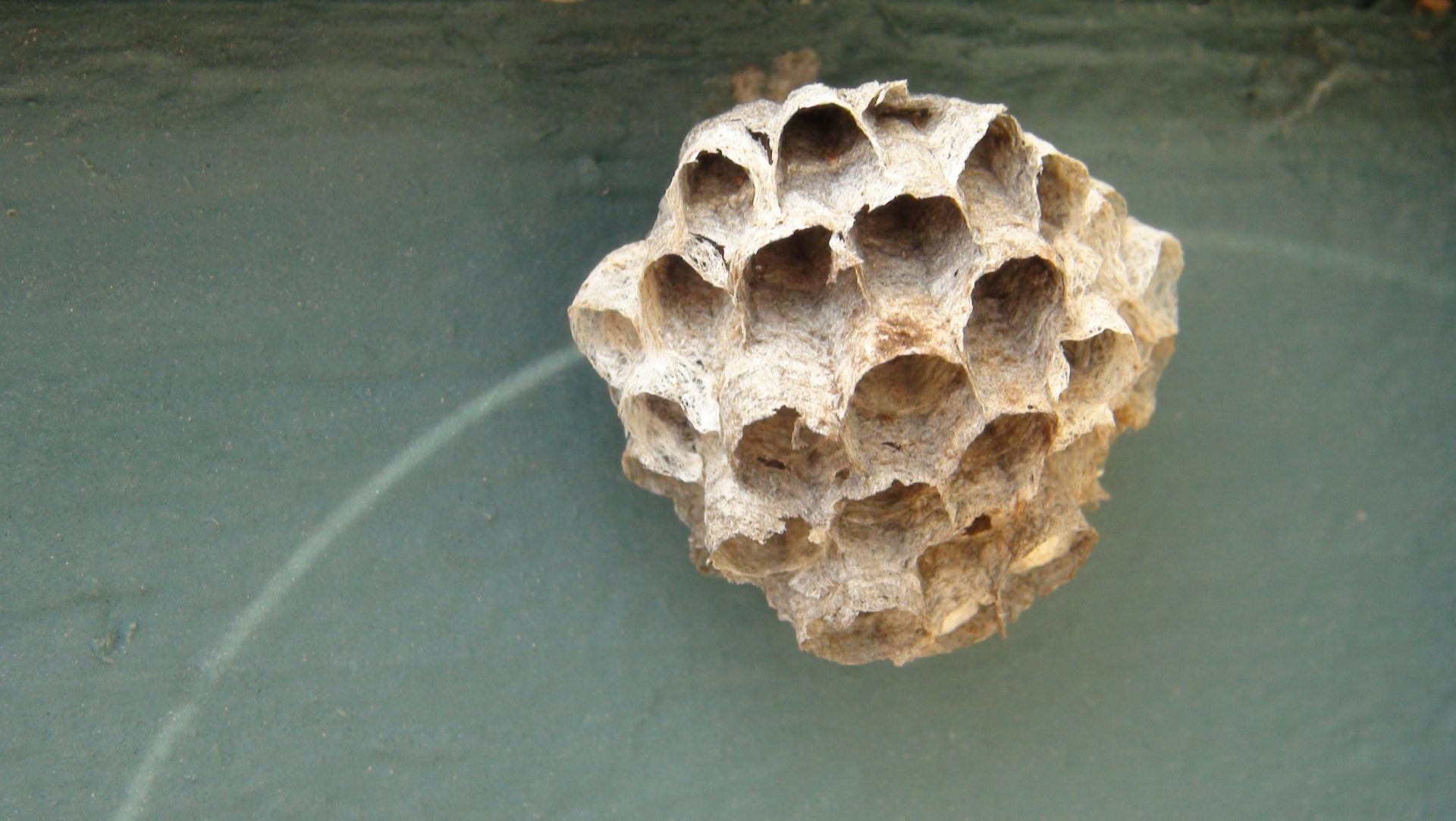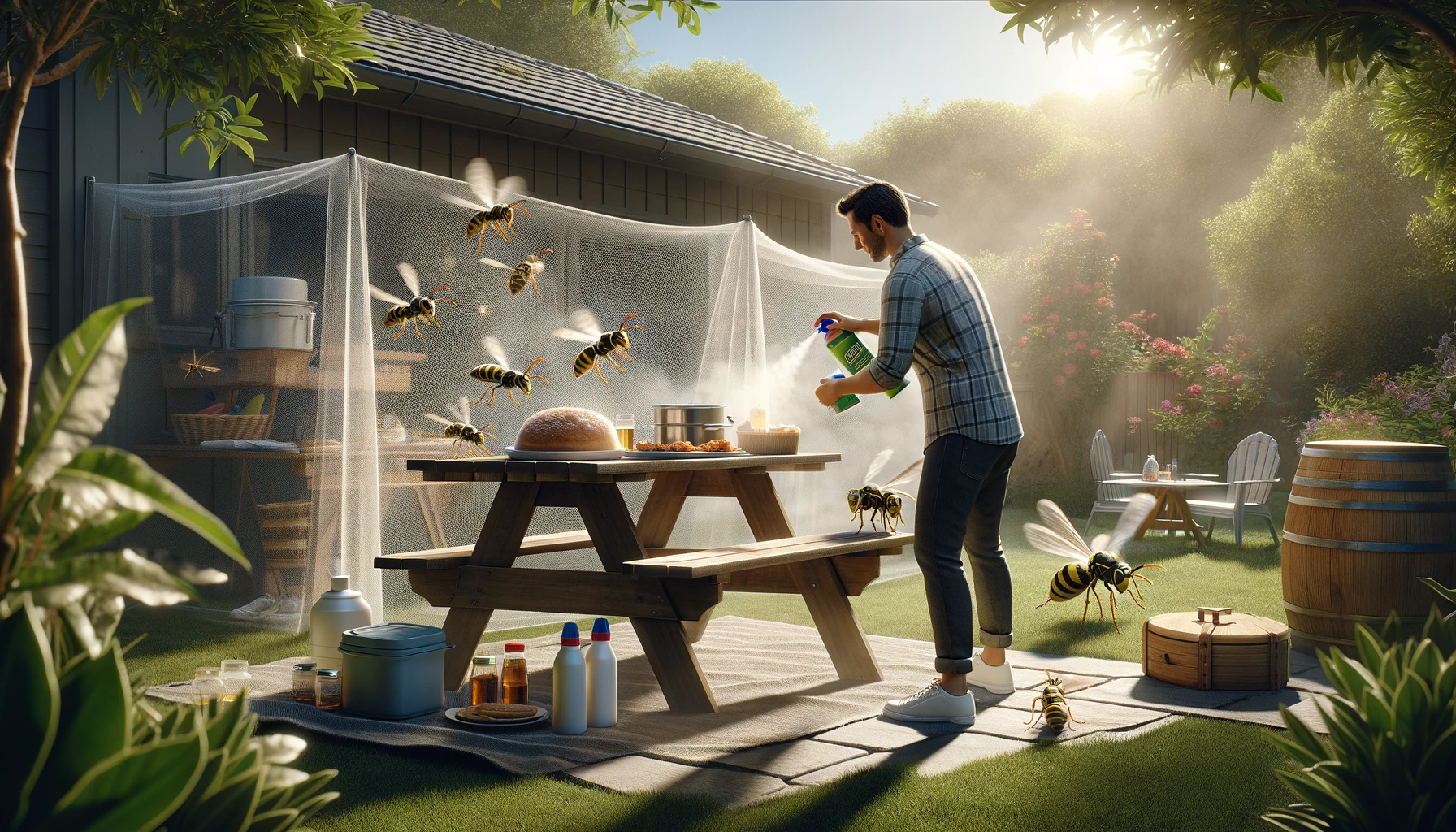Key Takeaways
-
Seal entry points: Prevent nesting by sealing cracks, screening vents, and blocking porch undersides.
-
Eliminate food sources: Keep garbage secure, clean outdoor areas, and manage compost properly.
-
Use natural repellents: Plant herbs and use essential oil sprays to deter wasps naturally.
-
Decoy nests help: Hanging fake nests can prevent wasps from settling nearby.
-
Early trapping: Use wasp traps early in spring to reduce wasp populations significantly.
-
Act quickly: Regular inspections and early removal of nests are crucial.
-
Professional assistance: For large or hidden nests, always seek professional pest control help.
 Imagine you’re enjoying a warm summer afternoon, sipping lemonade on your porch, when suddenly you hear that unmistakable buzzing sound. Wasps! Honestly, nothing ruins a relaxing day faster than an aggressive wasp colony.
But here’s the thing: preventing wasp nests isn’t complicated, and with a few easy steps, you can keep your home wasp-free. Here’s exactly what you need to know.
Imagine you’re enjoying a warm summer afternoon, sipping lemonade on your porch, when suddenly you hear that unmistakable buzzing sound. Wasps! Honestly, nothing ruins a relaxing day faster than an aggressive wasp colony.
But here’s the thing: preventing wasp nests isn’t complicated, and with a few easy steps, you can keep your home wasp-free. Here’s exactly what you need to know.
Why Do Wasps Choose Your Home?
First off, why your house? Wasps aren’t picking on you—it’s just business. Wasps look for three basic things: food, shelter, and a safe space to build nests. Unfortunately, our homes often provide precisely that. Think about your cosy porch ceilings, secure attics, garden sheds, and even those tiny cracks in your siding. To wasps, these places are prime real estate! So, what’s the solution? You just need to make your home less inviting. Let’s look at exactly how.Seal Up Potential Nesting Sites
- A queen wasp scouting for a new home needs only the tiniest gap to set up shop. To outsmart her, perform a quick inspection around your house each spring:
-
Fill cracks and holes: Grab a tube of exterior-grade caulk or expandable foam and seal any openings in walls, window frames, and under eaves. Even small gaps can turn into cozy wasp condos.
-
Screen vents and chimneys: Cover attic vents and chimneys with fine mesh screens. Wasps love nesting in these hidden spots, but simple screens can easily block their entry.
-
Close off decks and porches: Install mesh or lattice beneath porches and decks to prevent wasps from nesting underneath.


Not getting a solution?
Get your free pest control estimate today!Remove Food Sources That Attract Wasps
- Wasps are always hunting for their next meal; your yard might be an accidental buffet. Here’s how to eliminate temptation:
-
Secure garbage bins: Use garbage cans with tight-fitting lids and rinse them regularly. Wasps are especially attracted to sugary residues and protein scraps left behind.
-
Clean up after meals: If dining outside, promptly cover food, drinks, delightful beverages, and meats. Wasps have a sweet tooth and won’t pass up an easy meal.
-
Manage compost properly: Keep compost bins far from your house and cover food waste thoroughly to minimize odors that attract wasps.
-
Collect fallen fruits: Remove fallen fruits regularly if you have fruit trees. Overripe fruit on the ground is practically an open invitation for wasps.
Chemical Wasp Repellents
If wasps are a problem, consider using chemical repellents specifically designed to deter wasps. These can be sprayed around common nesting areas, such as under eaves and window frames and near outdoor dining spaces. Always follow the manufacturer’s instructions when using any chemical product to ensure your safety and the safety of those around you. Chemical repellents can provide a strong, long-lasting barrier that keeps wasps from building nests on your property.Use Natural Wasp Repellents
- Did you know certain smells repel wasps? These simple, natural deterrents can help keep your home wasp-free:
-
Plant strategically: Grow mint, basil, citronella, marigolds, and lavender around decks and porches. Wasps dislike these strong, fragrant plants and often avoid areas where they’re planted.
-
Essential oil sprays: Mix a few drops of peppermint, clove, or lemongrass essential oil with water and spray it around your porch and eaves. This homemade spray is safe, easy, and surprisingly effective.
-
Set out citronella candles: These aren’t just for mosquitoes—they can also discourage wasps from joining your outdoor gatherings.

Install Decoy Nests
Here’s a clever trick: wasps are territorial and usually won’t nest near another colony. You can discourage new nests from forming by hanging a fake wasp nest around your home (yes, they really exist).These decoy nests are inexpensive and available online or at local garden stores. Alternatively, a simple DIY solution—a crumpled brown paper bag resembling a nest—can do the trick!
Set Up Wasp Traps (Early in the Season)
Early spring is the prime time to trap queen wasps before they establish colonies. Place traps made with DIY methods filled with sweet bait (like sugar water or juice) around the perimeter of your yard.The trick is to position these away from high-traffic areas so wasps aren’t lured too close to your home. Reducing the queen population early can significantly cut down nest-building later.
Regular Inspections and Quick Action
- Even the best prevention methods aren’t always 100%. Wasps are persistent, and occasionally a nest might appear despite your efforts. The key is to spot and remove wasps and their nests early—before they become problematic:
-
Inspect regularly: Once a week during spring and summer, check eaves, decks, sheds, and garages for small nests.
-
Remove small nests immediately: When a nest is still tiny (golf-ball size or smaller), you can safely remove it yourself at night when wasps are less active. Spray it with a wasp killer from a safe distance, then knock it down.
Effective Wasp Nest Removal Strategies :
Check out these effective strategies to safely remove wasp nests and treat wasp infestation:| Method | Description | When to Use | Precautions |
|---|---|---|---|
| Professional Removal | Hire an expert to remove the nest. | Large nests or hard-to-reach areas. | Ensure the professional is licensed. |
| Insecticide Spray | Use wasp spray to kill wasps inside the nest. | Small, accessible nests, low wasp activity. | Wear protective gear and follow instructions. |
| Knock Down Nest | Remove the nest after treatment. | After killing wasps or during cooler months. | Ensure wasps are dead; wear protection. |
| Soapy Water | Spray soapy water to suffocate wasps. | Small, reachable nests. | Wear protection and have a quick escape route. |
| Vacuuming | Use a vacuum to safely remove wasps. | Ground nests or difficult areas. | Use a vacuum with a long hose. |

Know When to Seek Professional Help
Some nests, especially those in walls or underground, require professional intervention. Pest control specialists are trained, have proper gear, and know exactly how to remove nests safely. If you spot a large nest or see wasps frequently entering a small opening (indicating a hidden nest), it’s time to get expert help.By following these straightforward steps, you’ll significantly reduce your risk of hosting unwanted wasp visitors. And that means more carefree days enjoying your backyard—exactly as summer was meant to be.
 If you feel things have gone out of control, it is advised to contact pest control professionals. Our team can provide a customized approach to protect your home effectively.
If you feel things have gone out of control, it is advised to contact pest control professionals. Our team can provide a customized approach to protect your home effectively.
Visit our Species, Control, and DIY Guide sections for additional resources on wasps and ways to tackle a wasp infestation.





